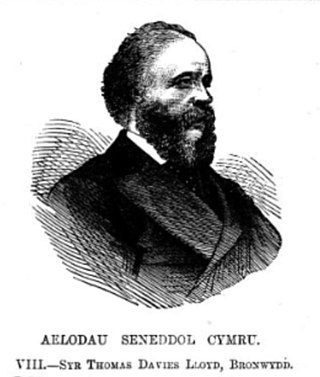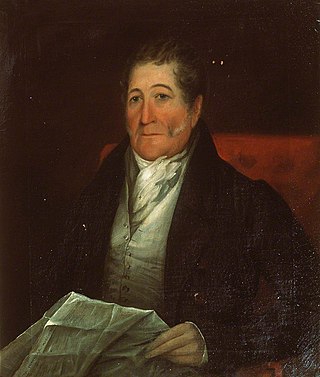Related Research Articles

Sir Thomas Myddelton (1586–1666) of Chirk Castle, Denbighshire, was an English-born Welsh landowner, politician, and military officer. He became a Member of Parliament in 1624; during the First English Civil War he was a prominent Parliamentarian general, despite having no previous military experience.
Sir Thomas Myddelton was a Welsh merchant who was Lord Mayor of London before becoming a Member of Parliament for London.

Sir Hugh Myddelton, 1st Baronet was a Welsh clothmaker, entrepreneur, mine-owner, goldsmith, banker and self-taught engineer. The spelling of his name is inconsistently reproduced, but Myddelton appears to be the earliest, and most consistently used in place names associated with him.

Sir Thomas Davies Lloyd, 1st Baronet was a British Liberal Member of Parliament, for Cardiganshire (Ceredigion) 1865–1868 and Cardigan Boroughs 1868–1874. Although he coveted a peerage and spent a fortune in pursuit of that aim, he had to be content with a baronetcy.
This article is about the particular significance of the year 1774 to Wales and its people.
The office of High Sheriff of Cardiganshire was established in 1541, since when a high sheriff was appointed annually until 1974 when the office was transformed into that of High Sheriff of Dyfed as part of the creation of Dyfed from the amalgamation of Cardiganshire, Carmarthenshire and Pembrokeshire. Between the Edwardian Conquest of Wales in 1282 and the establishment of the High Sheriff of Cardiganshire, the sheriff's duties were mainly the responsibility of the coroner and the Custos Rotulorum of Cardiganshire. The office of High Sheriff remained first in precedence in the county until the reign of Edward VII when an Order in Council in 1908 gave the Lord Lieutenant of Cardiganshire the prime office under the Crown as the sovereign's personal representative.

Sir Richard Myddelton, 3rd Baronet, of Chirk Castle, Denbighshire, was a Welsh landowner and Tory politician who sat in the House of Commons from 1685 to 1716.
John Campbell of Stackpole Court and Cawdor (1695–1777), was a British politician. He was a Member of Parliament (MP) for Pembrokeshire, Nairnshire, Inverness Burghs and Corfe Castle.
Sir John Pryce, 1st Baronet, sometimes also spelt Price, was an Anglo-Welsh Baronet and Member of Parliament.

Sir Richard Pryse, 2nd Baronet was a Welsh landowner and politician who sat in the House of Commons in 1660.

Sir Thomas Myddelton, 1st Baronet was a Welsh politician who sat in the House of Commons variously between 1646 and 1663. He supported the Parliamentary cause in the English Civil War but later took part in the Cheshire Uprising (1659) in support of the Restoration.

There have been two baronetcies created for members of the Pryse family, one in the Baronetage of England and one in the Baronetage of the United Kingdom. Both creations are extinct.
Sir Richard Pryse was a Welsh politician who sat in the House of Commons from 1584.
Sir John Lewis was a Welsh politician who sat in the House of Commons from 1604 to 1611.
Rowland Pugh was a Welsh politician who sat in the House of Commons from 1624 to 1625.
Richard Pryse may refer to:

Richard Myddelton, of Chirk Castle, Denbighshire, was a Welsh landowner and politician.
John Vaughan, 2nd Viscount Lisburne was a Welsh landowner and Whig politician who sat in the British House of Commons from 1727 to 1734. Apparently a heavy drinker, who kept several mistresses, he informally separated from his second wife in 1729 after she had an affair with his land agent. His spending badly impaired the financial soundness of his estate, and his brother and successor had to contend with the claims of Lisburne's wife's son on the estate.

Pryse Loveden Pryse of Gogerddan, Cardiganshire and Buscot Park, Berkshire was a British Lord Lieutenant and Member of Parliament for Cardigan Boroughs from 1818 until his death in 1849.

Gogerddan, or in English, Gogarthen, was an estate near to Trefeurig and the most important in what was then the county of Cardiganshire, Wales. Owned since at least the fifteenth century by the Pryse family, the main house, called Plas Gogerddan, still stands and is a Grade II listed building. The estate became especially wealthy from the seventeenth century on the profits from lead mining, which is when the house was constructed. The house was significantly altered in the 1860s and was sold by Sir Pryse Loveden Saunders-Pryse to University College of Wales in 1949.
References
- 1 2 John Burke A genealogical and heraldic history of the commoners of Great Britain, Volume 3
- ↑ Willis, Browne (1750). Notitia Parliamentaria, Part II: A Series or Lists of the Representatives in the several Parliaments held from the Reformation 1541, to the Restoration 1660 ... London. pp. 229–239.